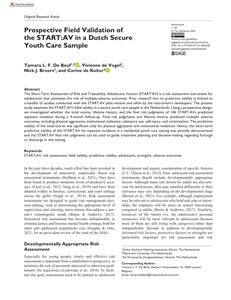Abstract Business Process Management (BPM) is an important discipline for organizations to manage their business processes. Research shows that higher BPM-maturity leads to better process performance. However, contextual factors such as culture seem to influence this relationship. The purpose of this paper is to investigate the role of national culture on the relationship between BPM-maturity and process performance. A multiple linear regression analysis is performed based on data from six different countries within Europe. Although the results show a significant relationship between BPM-maturity and process performance, no significant moderation effect of national culture has been found. The cultural dimension long term orientation shows a weak negative correlation with both BPM-maturity and process performance. Through a post-hoc moderation analysis on each dimension of BPM-maturity, we further find that long term orientation negatively moderates the relationship between process improvement and process performance. Three other moderation effects are also discovered. The results of this study contribute to insights into the role of culture in the field of BPM.
MULTIFILE

The importance of leadership is increasingly recognized in relation to digital transformation. Therefore, middle management and top management must have the competencies required to lead such a transformation. The purpose of this paper is to investigate the relationship between the digital leader competencies as set out by the European e-competence framework (e-CF) and the digital transformation of organizations. Also, the relationship between digital leadership competency (DLC) and IT capability is examined. An empirical investigation is presented based on a sample of 433 respondents, analyzed using PLS-SEM. The results strongly support our hypotheses. DLC has a strong impact on organizational digital transformation. A post-hoc analysis showed this is predominantly the case for the e-CF competencies of business plan development, architecture design, and innovating while business change management and governance do not seem to affect organizational digital transformation. This is the first empirical study to conceptualize, operationalize and validate the concept of DLC, based on the e-competence framework, and its impact on digital transformation. These findings have significant implications for researchers and practitioners working on the transformation toward a digital organization.
MULTIFILE

The Short-Term Assessment of Risk and Treatability: Adolescent Version (START:AV) is a risk assessment instrument for adolescents that estimates the risk of multiple adverse outcomes. Prior research into its predictive validity is limited to a handful of studies conducted with the START:AV pilot version and often by the instrument’s developers. The present study examines the START:AV’s field validity in a secure youth care sample in the Netherlands. Using a prospective design, we investigated whether the total scores, lifetime history, and the final risk judgments of 106 START:AVs predicted inpatient incidents during a 4-month follow-up. Final risk judgments and lifetime history predicted multiple adverse outcomes, including physical aggression, institutional violations, substance use, self-injury, and victimization. The predictive validity of the total scores was significant only for physical aggression and institutional violations. Hence, the short-term predictive validity of the START:AV for inpatient incidents in a residential youth care setting was partially demonstrated and the START:AV final risk judgments can be used to guide treatment planning and decision-making regarding furlough or discharge in this setting.
DOCUMENT

Conference proceedings International Symposium on Intelligent Manufacturing Environments
DOCUMENT

Wat is er op dit moment (medio augustus 2020) in de wetenschappelijke literatuur bekend over (de effecten van maatregelen tegen) de verspreiding van het coronavirus en wat is de betekenis daarvan voor organisatoren van evenementen?
DOCUMENT

What is known in scientific literature at this point in time about the effects of the measures against the transmission of the coronavirus and what is the meaning of this for the organisers of events?
DOCUMENT

Bespreking van onderzoek van Rychard Bouwens in ‘Waar wij trots op zijn. De ontdekkingen van 2011’ van de Universiteit Leiden Faculteit der Wiskunde & Natuurwetenschappen. Het valt goed te begrijpen voor iedereen met een basale kennis van klassieke fotografie: bij weinig licht neem je een lange sluitertijd. En dat is wat Rychard Bouwens deed. Om naar de zogenaamde Dark Ages van het heelal te kijken, hield hij de Hubble-ruimtetelescoop maar liefst 87 uur lang op een plek gericht.
DOCUMENT

Bespreking van onderzoek van Anton Akhmerov in ‘Waar wij trots op zijn. De ontdekkingen van 2011’ van de Universiteit Leiden Faculteit der Wiskunde & Natuurwetenschappen. De Leidse theoretisch natuurkundige Anton Akhmerov promoveerde in mei op een onderzoek naar functionele toepassingen van grafeen, een eenlaags koolstofmateriaal dat de afgelopen jaren volop in de belangstelling staat. Daarnaast werkte hij ook nog aan quantumcomputers, omdat hij tijd over had in zijn onderzoek.
DOCUMENT

Bespreking van onderzoek van Erik Danen in ‘Waar wij trots op zijn. De ontdekkingen van 2011’ van de Universiteit Leiden Faculteit der Wiskunde & Natuurwetenschappen. Celbioloog Erik Danen doet onderzoek naar de verwoestende – maar in evolutionaire termen ook wonderlijke – strategieën van de kankercel. Met welke trucs verspreiden kankercellen zich door het lichaam? Hoe overleven ze een aanval van een chemokuur? En hoe wrang is het dat de één procent cellen die de therapie overleeft vervolgens dubbelhard terugslaat.
DOCUMENT
